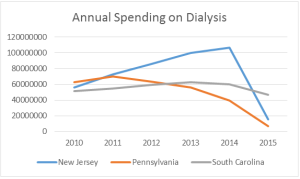On June 16, 2017, the Centers for Medicare & Medicaid Services (CMS) released Transmittal 236. This Transmittal makes some minor changes to Chapter 10 of the Medicare Benefit Policy Manual. Specifically, CMS is clarifying its definitions related to the “ALS assessment” and “locality.” The change to the locality definition has prompted some discussion within the industry as to the impact on Medicare’s reimbursement for mileage beyond the nearest appropriate facility. In this month’s blog, I will explain the recent change, and hopefully convince you that this isn’t something that should cause you undue concern.
Medicare’s Definition of “Locality”
The definition of “locality” appears in Section 10.3.5 of Chapter 10 of the Medicare Benefit Policy Manual. That definition reads as follows:
The term “locality” with respect to ambulance service means the service area surrounding the institution to which individuals normally travel or are expected to travel to receive hospital or skilled nursing services.
CMS then includes the following example to explain how that definition should be applied to real world situations:
EXAMPLE: Mr. A becomes ill at home and requires ambulance service to the hospital. The small community in which he lives has a 35-bed hospital. Two large metropolitan hospitals are located some distance from Mr. A’s community and both regularly provide hospital services to the community’s residents. The community is within the “locality” of both metropolitan hospitals and direct ambulance service to either of these (as well as to the local community hospital) is covered.
Conceptually, the locality definition is intended to address situations where there are several local options that residents of a community could choose for the receipt of necessary medical care. CMS recognizes that a strict adherence to its general policy of only covering mileage to the nearest appropriate facility would undermine a patient’s right to choose from these various institutional health care providers. The locality definition ensures that, when the two or more facilities are reasonably close to one another, the patient can safely choose the further facility without fear that they may end up being responsible for some incremental portion of the mileage.
The Proposed Clarification
Effective September 18, 2017, Transmittal 236 adds the following sentence to the end of the current definition of locality:
The MACs have the discretion to define locality in their service areas.
Analysis of the Proposed Clarification
The first question that should be asked is whether this clarification is actually a change in CMS policy? I would argue that it not, as Medicare Administrative Contractors have always had the discretion to define what constitutes the “locality” for an ambulance transport. For that reason, I view the purpose of this Transmittal as simply clarifying “who” (i.e., CMS vs. the MACs) has the primary responsibility for making these determinations.
Nor do I believe that this clarification is being made in response to potential abuse of the locality issue, either by providers billing for excess mileage under an expansive reading of “locality” or by the MACs in processing claims. Rather, I think this clarification is being made in response to repeated questions from the provider community, both on Open Door Forums and at state association meetings with their MACs. In other words, I think CMS is simply making clear that concerns regarding locality should be raised with the MACs, rather than CMS itself.
The Transmittal does leave open the possibility that MACs could impose their own definitions of locality. However, as I noted above, they already have this authority. I am not aware of any MAC ever electing to define the issue. Typically, the MAC will simply restate the CMS Manual definition of locality in its LCD.
So why have MACs been reluctant, up to this point, to define localities? I think it has to do with the administrative burden that would be involved. First and foremost, the MAC would need to have a sense of the larger demographic trends that dictate patient referral patterns in any given area. While that information is available, in theory, it is not available in any way that is readily useable by the MAC. Moreover, as the test focuses on what is “normal” or “expected” for patients, this would be a moving target, as patient preferences change over time, new facilities open, other facilities close or change the services they offer, etc. Thus, to the extent a MAC defined a locality, it would be constantly forced to revisit that definition every so often. Finally, the MAC would have to make allowances for transports that are outside the locality, but where the patient is seeking specialized care that may not be available within the locality.
In sum, defining the locality for even a single community would be a significant administrative burden on the MAC. When you consider that there are hundreds, if not thousands of distinct communities within each state, you can understand the MACs reluctance to offer specific guidance on this approach.
Instead, I believe that the MACs will continue to address the mileage issue in the same way they have done up to this point. Most MACs have imposed an upper limit on the mileage they will pay without question. This upper mileage limit may be for its entire MAC Jurisdiction, it could be statewide, or it could have two or more mileage limits for a particular state. For example, some MACs use a smaller mileage edit for transports that originate in and around a major metropolitan center, and a larger mileage edit for transports in the more rural areas of a state.
This approach offers a number of administrative benefits to the MAC. First, it limits the number of claims that run afoul of the edit, and therefore that potentially may need to be reviewed by the MAC on appeal. It also offers clarity to the provider community.
So, if your MAC has previously indicated that it has a mileage edit, I think you can safely assume that this will continue to be the guiding principle used by the MAC after the effective date. If the MAC doesn’t have a published mileage edit, I don’t think that is likely to change come September.
I would suggest that ambulance providers continue to monitor their remittances. If you are seeing mileage over a certain amount consistently denied by the MAC, that is their mileage edit. Please note that the MAC is not indicating this mileage is never covered, just that it has determined that it will not necessarily pay this higher number of miles without seeing the underlying documentation. In other words, the MAC is putting the burden on you to prove that the entire mileage was covered. If you are not seeing mileage being denied, I wouldn’t expect that to change either. I hope this helps to put everyone’s mind at ease.
Have a wonderful Fourth of July.
Have an issue you would like to see discussed in a future Talking Medicare blog? Please write to me at bwerfel@aol.com.
















